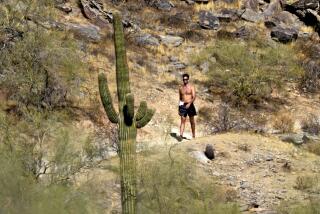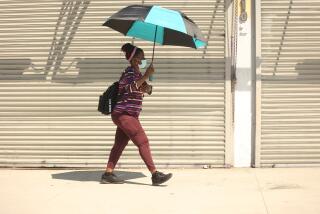Hot Spell Sours Produce, Moods
MADERA, Calif. — Just north of the San Joaquin River, deep in the sandy loam, the brutal July heat is turning Steve Schafer’s grape field into vinegar.
Schafer, a fourth-generation Volga German farmer, is racing to pick his 70 acres of red table grapes -- a variety aptly called Flame -- before the bunches rot and the vineyard turns sour.
July is never easy in the San Joaquin Valley, but this season’s harvest has fallen under a sun gone cruel. For 16 straight days, the temperature has broken the 100-degree mark -- 101, 103, 105, 107 and higher -- searing crops and wilting farmworkers. If not for July 13 when the high for the day plummeted to 99 degrees, this irrigated flatland would have broken its record of 20 consecutive days of triple-digit heat.
The Flame, summer’s first seedless red grape, is literally weeping on the vine. From Bakersfield to Madera -- the 150-mile-long heart of America’s table grape country -- about 25% of the bunches are oozing sugar from cracks in their skin. Berry to berry, the juice drips and ferments and eats through an entire cluster in no time.
“Taste that grape,” Schafer says, grabbing a bunch too damaged to bother picking. “The suture on the skin can’t handle the heat, and it just popped open. Like a hernia. Sour, isn’t it?”
The farmer isn’t the only one sounding surly in this stew. Longtime residents always have taken comfort in the relative dryness of a valley summer, but not this July. For the last three weeks, the humidity has barged through the door like an intruder from Philly.
Dan Gudgel, a National Weather Service meteorologist based in nearby Hanford, insists the humidity is only 10% higher than in past years -- and is mostly a consequence of all those housing tracts and strip malls swallowing up farmland.
Still, he says, residents have a right to feel put upon. They’d have to go back to 1908 to find a July with more triple-digit days. And because cities then were small country villages that created almost no humidity, this July just might rank as the most miserable on record.
“It may be that the heat index has never been worse,” Gudgel said.
Residents appear to be heeding warnings to drink plenty of water and stay indoors with the air conditioning running, a boom to a Pacific, Gas & Electric that only two summers ago couldn’t keep the lights on. Hospitals in Madera and Fresno counties report only a slight rise in heat stroke cases.
With no cool front in sight, some farmers’ wives are packing up the children and heading to Santa Cruz to ride out the last days before school. Their wheezy-lunged husbands, steroid inhalers in hand, are left to battle another day of putrid air and decaying fruit.
Many Crops Hurt
July’s oven-baking weather, coupled with an unusually wet and cool spring, has pummeled more than just the Flame. Walnut groves, their canopies sunburned, are dropping nuts a month shy of harvest. Heat stress is forcing tomato plants to shed their flowers and cotton plants to abort their bolls.
The San Joaquin Valley, regarded as nature’s perfect marriage of sun and soil, home to 250 types of fruits and vegetables, has become a freakish hothouse. Varieties of peaches, plums and nectarines, bred to sweeten at different times so they can capture different markets, are ripening one on top of the other.
The gaps that give a farmer room to breathe are closing fast. The Crimson seedless, for instance, normally a late summer and early fall grape, is building color and will surely crash into the back end of the Flame harvest.
“July is making up for all the cool weather we had back in February and April, but it’s doing it way too fast,” grumbled Luther Khachigian, owner of Cal West Nursery in Visalia, who grows grapes and walnuts.
“February was two degrees below normal, and then along comes April and it’s four degrees below normal, and then here comes July and it’s five degrees above normal. Those fluctuations play hell with a farmer.”
Hoping to beat the rot that grips his vineyard, the 46-year-old Schafer is spending an extra $1,500 a day on labor. Field hands clip off the bad berries and pack bunches every bit as clean and tasty -- if not as big -- as harvests past.
“We’re probably spending 30% more a box to clean things up,” he said. “But once we get it bagged and packed, the consumer is getting a darn good grape: red and crisp and one of the best-tasting around.”
Schafer, a stout man in Wrangler jeans, Tony Lama boots and an $8 straw hat, watches his words when talking to city folk. Too often, he says, farmers come off like whiners, complaining when foul weather cuts yields and great weather pumps them up. This year, he figures, his crop will be down 25% to 30%, though prices have remained steady.
“Last year, my Flames were perfect but so were everyone else’s. The prices at the end were lousy, and I ended up dumping 800 boxes,” he said. “I guess the ideal would be a perfect crop and high prices, but that’s never going to happen.”
Schafer, a father of three who coaches youth baseball seven months a year, tries to take the long view. He recalls the tough times of his forbears, German wheat farmers lured to Russia’s Volga River area by Catherine the Great. Tens of thousands of Volga Germans, unwilling to give up their language and strict ways, eventually were forced to flee Russia in the face of czarist persecution.
Legacy of Farming
Philip Schafer, his great-grandfather, came to Sanger in 1902 and started growing raisins. By the mid-1950s, Schafer’s father, Corky, had gone into the business. Father and son now farm 2,500 acres of wine and table grapes and almonds in Madera County.
For almost 20 years, they have been growing the Flame, one of the valley’s workhorses. Developed in the 1960s by a U.S. Department of Agriculture plant breeder, the Flame boasts a complex parentage: part Thompson seedless, part Red Malaga, part Muscat of Alexandria and part Tifafihi Ahmer, a Middle Eastern variety that imparted its crispness. The Flame’s popularity with consumers brought a stampede of plantings that have leveled off at 26,000 acres statewide.
On Tuesday, Schafer stood in the 102-degree sun and gazed down the quarter-mile rows of his vineyard in the old Italian Swiss Colony section. Thousands of culled Flames lay squished beneath the worn-out tennis shoes of the field workers from Oaxaca, Mexico.
Miriam Cortez, a 19-year-old grape picker with an 11-month-old baby at home, says she can feel the heat when she wakes up each day at 4 a.m. to cook beans, carne and tortillas to take to the fields.
“We start in the fields at 5:30 in the morning, and you can already feel the heat coming out of the ground,” said Cortez, her Dallas Cowboys hat bleached by the sun and three bandanas covering her ears and lower face. “Sometimes we wait all day for a little breeze to come.”
It was 11 a.m., more than five hours into the workday and time for the crew of 22 pickers and packers to take a break. Cortez’s parents, Jesus and Jaime Placido, found a spot beneath a curtain of vines, just out of reach of the sun, and sat down. They munched on slices of watermelon and cantaloupe and tried not to drink too much water.
“It makes you tired and your stomach slosh,” Jesus said.
Not since the summer of 1996, when August brought nine straight days of 100-degree temperatures, have they toiled in such heat. Many farmers like Schafer, concerned about the health of their crews, have been cutting short the workday by an hour.
“We Oaxacans came here to work and not complain,” Jesus said. “But 1 o’clock is the worst part. You have only an hour to go, but that hour is a long one.”
More to Read
Sign up for Essential California
The most important California stories and recommendations in your inbox every morning.
You may occasionally receive promotional content from the Los Angeles Times.










